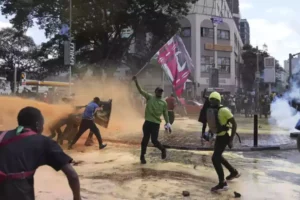To tackle the impacts of climate change and biodversity loss, the countries of Africa’s Sahel region are mounting an epic response: a “wall” of restored forests and lands stretching more than 8,000 km across the continent.
The Great Green Wall is a spectacular initiative designed to help people and nature cope with the growing impact of the climate emergency and the degradation of vital ecosystems, and to keep the Sahara desert from spreading deeper into one of the world’s poorest regions.
Launched by the African Union in 2007, the Great Green Wall has grown from an ambitious tree-planting drive into a comprehensive rural development initiative. The goal has shifted from a literal wall of trees to transforming millions of lives by creating a mosaic of green and productive landscapes across 11 countries. So far, almost 18 million ha of degraded land have been restored.
“This remarkable initiative is already making a difference in the lives of many people across Africa, including in countries prone to conflict,” said Mirey Atallah, the head of the Nature for Climate Branch at the United Nations Environment Programme (UNEP). “It also shows the huge benefits of restoration in landscapes acutely at risk from climate change.”
The initiative has been selected among the first 10 World Restoration Flagships of the UN Decade on Ecosystem Restoration. The flagships are inspiring examples of how landscape-scale restoration can address the triple planetary crisis of climate change, nature and biodiversity loss, and pollution and waste.
By 2030, the Great Green Wall aims to restore 100 million hectares of land, sequester 250 million tonnes of carbon and create 10 million jobs. It is providing food and water security, habitat for wild plants and animals, and a reason for residents to stay in a region beset by drought and poverty.
Boosting local initiatives
While vulnerable communities all the way from Senegal in the west to Ethiopia in the east stand to benefit, the awarded flagship initiative has a particular focus on Burkina Faso and Niger.
Kollo, Niger is one of several municipalities where the Food and Agriculture Organization (FAO) of the United Nations, UNEP, government authorities and other partners are helping communities to restore forests and soils.
With support from donors, including France and Germany, the initiative is helping communities in Niger and neighbouring Burkina Faso to roll out restoration projects and develop the capacity to plan and implement their own green investments

The initiative “supports green entrepreneurs to ensure the implementation of sustainable restoration investments and provides multiple benefits to the most vulnerable populations,” said Christophe Besacier, coordinator of the FAO’s Forest and Landscape Restoration Mechanism.
It is an approach that could be scaled up across Burkina Faso, Niger and neighbouring countries, “offering hope for a better future at a time when conflict and insecurity are adding to the pressures on communities,” Besacier added.
A helping hand for nature
In Kollo, farmers have deployed a traditional technique to recover degraded land and prevent desertification by digging holes or crescent-shaped ditches. Also called “zai pits” and “half-moons”, the ditches capture scarce rainwater and direct it toward growing plants.
Another proven method called assisted natural regeneration involves enclosing areas of land to protect trees and other vegetation from grazing animals and woodcutters, and allow them to regenerate. Once established, the shady plots can also provide good conditions for growing crops or keeping bees.

Photo Credit: Artisan Productions / UNEP
Djibo Dandakoye, a farmer, says fodder from his fenced plot sells for 200 Central African francs (about US$0.35) per bundle, a valuable source of sustainable income that is shared between the families who tend the plots and village and municipal authorities.
“This land used to be completely dry and bare,” said Dandokoye, sitting in front of the tall bundles of golden hay tied with green stems. “The trees and grass that you see now are the result of hard work, from the trees we planted and the seeds we sowed. We were paid for our labour and now we are reaping the benefits.”
Women taking the initiative
Men and women are also being trained in agroforestry practices and other ways to boost their income.
The project has enabled women in Kollo to secure land where they are growing moringa trees, whose nutritious leaves and seed pods can be eaten as a vegetable, dried and ground into powder, turned into oil or even used to filter water. The cooperative has built a small shop where the women prepare and sell products, including soaps, cookies and cakes.

“Moringa has commercial value and supports many families,” said Salamatou Souley, the mayor of Kollo. “It has really changed the lives of the growers. It is also important to create these cooperatives because the production of moringa fits perfectly with the restoration of the land.”
Souley said reversing the loss of cultivable land to degradation and desertification was the key to developing her rural municipality.
“My motivation is really to advance the position of women, to support the entrepreneurship of women and youth and to develop my municipality, one way or another,” she said.
About the UN Decade on Ecosystem Restoration
The UN General Assembly has declared the years 2021 through 2030 the UN Decade on Ecosystem Restoration. Led by UNEP and the Food and Agriculture Organization of the UN together with the support of partners, it is designed to prevent, halt, and reverse the loss and degradation of ecosystems worldwide. It aims at reviving billions of hectares, covering terrestrial as well as aquatic ecosystems. A global call to action, the UN Decade draws together political support, scientific research and financial muscle to massively scale up restoration.
What is a World Restoration Flagship?
Countries have already promised to restore 1 billion hectares – an area larger than China – as part of their commitments to the Paris climate agreement, the Aichi targets for biodiversity, the Land Degradation Neutrality targets and the Bonn Challenge. However, little is known about the progress or quality of this restoration.
With the World Restoration Flagships, the UN Decade on Ecosystem Restoration is honouring the best examples of large-scale and long-term ecosystem restoration in any country or region, embodying the 10 Restoration Principles of the UN Decade. Progress of all 10 World Restoration Flagships will be transparently monitored through the Framework for Ecosystem Restoration Monitoring, the UN Decade’s platform for keeping track of global restoration efforts.
Source : Unep















